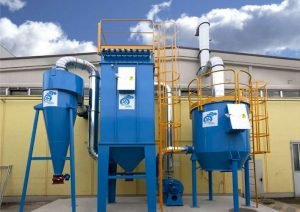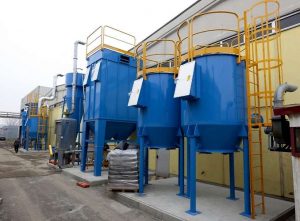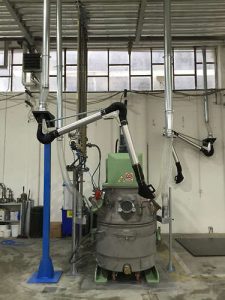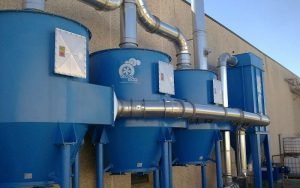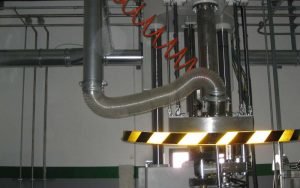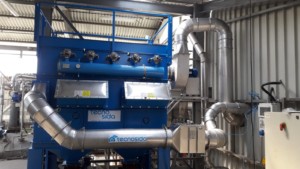Industrial suction and abatement plants for chemical industry emissions
Below we describe in detail three of our solutions in the field of adhesive, chemical and herbicide production
Application 1: manufacturing of adhesive and home-care products
The customer is a world leading company in the manufacturing of adhesives, cosmetics and home-care products. In preparation for the creation of a new production department, the customer contacted Tecnosida® and asked for the design of two suction and filtering plants customized according to the needs of the new area.
The production lines imply the extensive use of chemical intermediates and raw materials, such as epoxy and silicone resins, containing variable quantities of calcium carbonate, carbon black and crosslinking resins. Considering the explosive nature of these compounds, the plant must comply with the ATEX Directive.
Suction and abatement plants for chemical industry: dust treatment and VOC abatement
After a technical inspection, Tecnosida® designed and manufactured an industrial suction system composed of:
- collection system to protect internal users of production areas;
- pipe network to convey the airflow and the vapours into the abatement system. The flexible drop lines are equipped with shutters for the exclusion of open and/or closed collection points according to the production;
- step by step system made by multistage dust collectors and adsorbers for treatment and control of chemical emissions in compliance with the limits required by the Italian legislative decree 152/06.
Below we describe in detail the plant structure.
Phase 1 – Chemical emission collection
Tecnosida® carries out a design study for the balancing of a line composed of 20 emission points to suck the pollutants directly from the source. According to the specific need of the machine and of the place of work to be protected, suction arms and hoods for the connection to suction couplings have been selected and implemented. The system and the equipment have been designed in compliance with the ATEX Directive and completed with an equipotential connection of metal mass for earthing.
Phase 2 – multistage abatement section
For the abatement of the different pollutants in the airflow, two multistage treatment lines have been designed and manufactured. These lines are composed of:
- A cyclone system for the pre-separation of dusty compounds with a high granulometry and a rotary valve for discharge. The cyclone is ATEX II 3 D certified;
- A Dustdown® self-cleaning bag filter for the abatement of dust with a very fine granulometry. The filter is equipped with a rotary valve, explosion vents and complies with the ATEX Directive;
- A Chemsorb®, activated carbon filter, for the adsorption of chemical emissions and vapours (VOCs) in the airflow. This filter is equipped with explosion vents and is ATEX II 3 GD certified.
Phase 3 : installation and testing
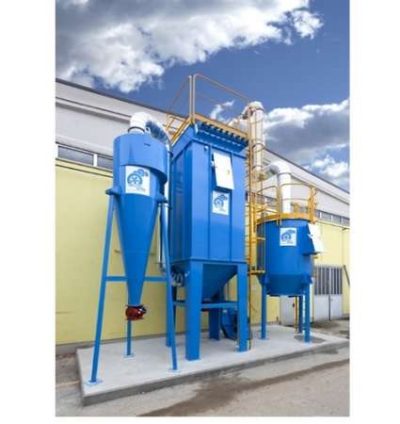
The delivery of the turnkey plant includes the electrical panels, the connection of the utilities and inverters/pressure stabilisers for the management of the collection points opening at the same time.
Our specialized technicians carried out the final testing and calibration of all the parameters of the plant. The system has been manufactured in compliance with the italian reference BATs (D.MM.01 for the cyclone, D.MF.01 for filtering and AC.RE.01 for the adsorption part on activated carbon) and reduced the pollutant emissions, solving the customer’s problems.
Application 2: chemical agent production
The customer is a worldwide company that deals with speciality chemicals and intermediate products, such as cationic and anionic surfactants, polyurethanes, adhesives, sealants and speciality chemicals for the textile industry.
The customer’s plants are in continuous operation (24h) and include complex connection points, mixing areas, loading units for components, vat and parts washing equipment. In such a diversified field, the need to collect and abate dust (both of mineral and polymeric origin) and solvent vapours (VOCs) containing traces of isocyanates has emerged. This mixture of dust and solvents could be flammable and even explosive. For this reason, the suction and abatement system has been designed and manufactured in compliance with the ATEX European Directive.
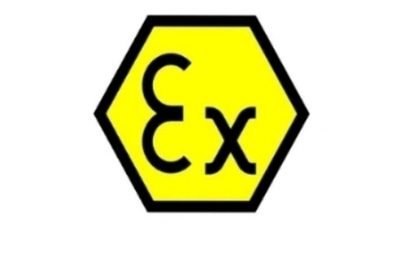
Suction and abatement plants for chemical industry: dust filtration and VOC abatement through activated carbon
After an extensive technical inspection, Tecnosida® has designed and manufactured a ready-to-use industrial suction system, composed of:
- suction arms and hoods appropriately sized to collect pollutants from production machines. In this application, all the components are ATEX certified and can be used in a potentially explosive atmosphere;
- pipes for conveying the airflow into the abatement system;
- two-stages abatement plant: the first stage filters the dust in the airflow, while the second stage abates VOCs and vapours deriving from the use of solvents.
For dust abatement, an ATEX certified Dustdown® bag filter suitable for removing fine and ultrafine dust in a potentially explosive atmosphere was used. In addition, to abate VOCs, three ATEX certified Chemsorb® activated carbon filters in the vertical version were installed.
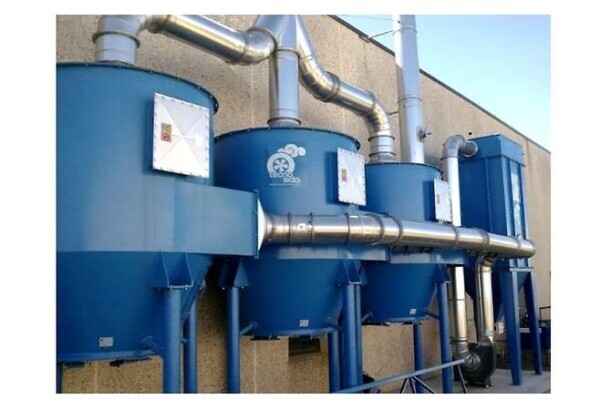
The industrial suction system was manufactured in compliance with the reference BATs (D.MF.01 for the filter and AC.RE.01 for the activated carbons) and it reduced pollutant emission, solving the customer’s problems.
Application 3: dedusting in herbicide production lines
This company deals with the formulation and packaging on behalf of third parties of liquid chemicals, plant protection products and agrochemicals for the agricultural sector. The customer requested the replacement of a pre-existing industrial suction system used on mixers to produce insecticides and herbicides. The system did not comply with the current directives (especially the ATEX one) anymore and no longer met the needs of the customer, who had changed the herbicide production line over the years. It was necessary to increase the airflow and the filtering surface (around 50% greater than the existing system) to have an additional operating and functional margin.
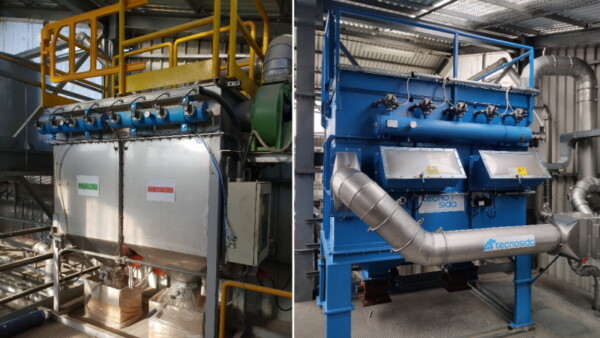
Suction and abatement plants for chemical industry: ATEX bag filter for insecticide and herbicide dust
After the initial contact, Tecnosida® carried out the usual technical-economic inspection, analysing the customer’s needs and the issues linked to the available spaces. Below are the needs identified during the inspection:
- it was necessary to connect the new industrial suction system to the existing dust collection plant;
- it was necessary to place the system, particularly the filter, on a small deck (the height at the highest point was around 3 m)
Tecnosida® then proceeded to size and design a customized filter, adapting it to the customer’s available spaces by using special small filtering bags and consequently adjusting the other components of the filtering system. The ATEX dust collector is made of stainless steel and it is composed of:
- Settling chamber: it is located at the entrance of the filter. In addition to slowing down and spreading out the airflow, it allows the coarse dust to decant, reducing the concentration of the pollutants coming into contact with the bags. This technical measure is used to preserve the filtering elements as much as possible when handling pollutants which could damage the bags (hygroscopic dust, abrasive dust…);
- Filtering section: it is composed of bags made of filter cloth with antistatic and water-oil repellent properties;
- Hoppers equipped with electric moto-vibrators: normally, the dust discharge hoppers must have an inclination greater than 50 degrees to facilitate the flow of the pollutant along the walls and, consequently, its discharge. In this case, due to the small spaces, it was not possible to guarantee a sufficient inclination. Therefore, the two hoppers have been equipped with electric moto-vibrators, shaking the walls with their movement and facilitating the fall of dust, avoiding accumulation. For discharging the residues, ATEX certified rotary valves have been installed in the terminal part of the hoppers, also acting as isolation of the filter in case of explosion. Containers have been placed under the valves to collect the pollutant;
- Explosion vents: since the filter is located in an ATEX atmosphere and treats potentially explosive dust, it has been equipped with breakage panels to vent any potential explosion. As shown in the picture, the panels are placed in the frontal part of the filter and allow to vent the pressure of a potential deflagration inside the dust collector towards the outside, saving its structure and protecting the surrounding environment. For safety reasons, the customer also implemented conveying pipes which, in case of explosion, release the pressure over the roof of the building.
The industrial suction system is also equipped with:
- Conveying pipes: they connect the existing suction pipes to the filter and the suction system to the existing exhaust pipes;
- Isolation flap valve: it is located before the filter and in case of explosion it avoids the propagation of the deflagration along the suction pipes;
- Electrical panel: it is used to control and monitor the system. In this application, it is equipped with an inverter, guaranteeing the best airflow regulation according to the real production and operational needs, saving energy. The panel has been created for the connection of ATEX utilities, but it is located in a non-ATEX area.
As we have seen, the system and all of its components have been manufactured in compliance with the ATEX Directive and the relevant BAT documentation.
